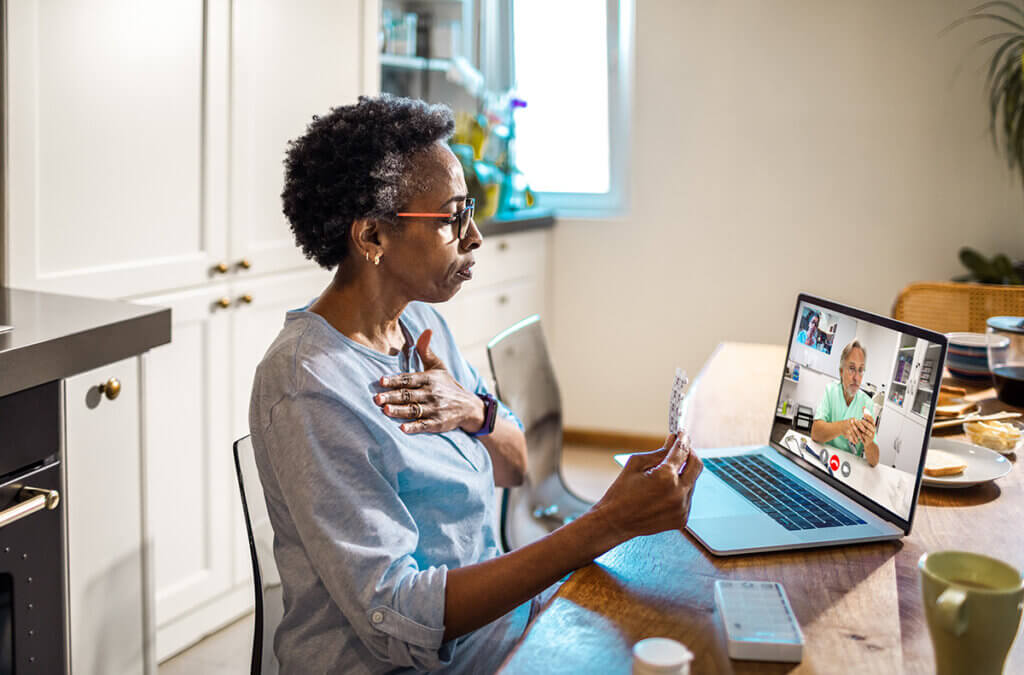4 times to try telemedicine—and when an in-person visit is better
In-person care is still the gold standard, but sometimes you don’t need to see your doctor to get the healthcare you need. Here are 4 times to try telemedicine services.

Telemedicine has been around for years, but its popularity skyrocketed during the early days of the COVID-19 pandemic. In fact, the number of visits jumped 154%. And although that number has gone down since then, it seems that telemedicine is here to stay.
“I can’t tell you how many of my patients prefer telemedicine to in-person visits now,” says Michael Hochman, M.D. Dr. Hochman is a Los Angeles internist and host of the Healthy Skeptic, MD podcast. “In medical school, we’re taught that 80% of the diagnoses come from the medical history, and a physical exam isn’t often necessary.” That doesn’t mean there’s no value in a face-to-face visit, which can build rapport. But “three-fourths of the time, we get what we need from a telemedicine visit,” Dr. Hochman notes.
So when should you skip the doctor’s office and schedule a video chat or phone call instead?
4 Good times to use telemedicine
1. You’re checking in with your doctor about a chronic condition.
If you have a condition such as high blood pressure, type 2 diabetes, or arthritis, your doctor may want to check in regularly. Topics they’ll want to talk about include:
- Sticking to your medication schedule.
- Lifestyle habits.
- At-home monitoring.
- Reviewing your treatment plan.
- Questions you might have.
“Most of the time, this can be done via telehealth, especially if it’s a provider you know well,” says Dr. Hochman. Just make sure you have all the equipment you need and are using it correctly. If you have a blood pressure cuff, for example, have your doctor’s office check it against their model. Research has shown that about a third of home blood pressure monitors are off by at least 5 points.
If you need bloodwork done, you’ll have to go to a laboratory, of course. But your doctor can go over the results with you at a virtual visit.
2. You need mental health services.
Even before the pandemic, research showed that teletherapy was just as effective as in-person talk therapy. In fact, people were more likely to stick with therapy if it was virtual. One reason for that: It’s often much easier to access. Your therapist is just a quick Zoom call away, so you don’t have to drive or take public transportation to get to them, notes Dr. Hochman.
To make the most of your virtual visit, silence other electronics. That way, the urge to reply to texts or emails won’t take over your session.
Many health insurance plans offer free programs that help members manage mental health concerns such as stress and anxiety. Reach out to your health plan to see how you can make the most of your benefits.
3. You’re not sure if your symptoms need a doctor’s visit.
Whether it’s a twisted ankle or a fever, a virtual visit can get you the answer to this common question: Do I need to see my doctor in person or head to urgent care or the ER? Research suggests that a telemedicine visit will provide similar care to what you’d get in your doctor’s office.
Patients who use telemedicine for upper respiratory infections, for example, get adequate care, a recent study found. And they likely won’t be given medications that aren’t needed, such as antibiotics. “Believe it or not, we can actually have a patient angle their phone or iPad computer and shine a flashlight into their throat so we can get a good look,” says Dr. Hochman.
4. You’re getting routine preventive care.
Many patients will still choose to complete routine wellness visits in person. But telemedicine is a great way to talk about preventive screenings you may need, says Dr. Hochman. Examples include a colonoscopy or prostate cancer screening. Virtual visits can also help if you’re dealing with a new diagnosis, or if you’re thinking about getting a certain medical procedure. Your doctor can answer questions and offer suggestions.
3 Times to see your provider in person
Alas, not all healthcare needs lend themselves to telemedicine. Here are 3 situations that require meeting in person with your provider.
1. Your doctor needs to run tests for a diagnosis.
Maybe your doctor isn’t sure whether the sore throat you described is due to strep, the flu, COVID-19, or the common cold. Since treatments for each differ, they’ll probably want you to come in for testing.
“We also can’t really look into people’s ears during a virtual visit. So if we think you have an ear infection, we’ll want to see you in person to make sure,” says Dr. Hochman. And if the doctor suspects a broken bone, you’ll need to come in for an exam and have an x-ray.
2. Your doctor needs to be hands-on.
If you suffer from arthritis and are having a bad flare, your doctor will want to see you and physically examine the joint, says Dr. Hochman. Ditto for listening to your heart, changing a surgical dressing, or fitting you for a post-surgical boot.
3. It’s a medical emergency.
If you have any of the symptoms below, you need urgent in-person medical care:
- Chest pain or difficulty breathing.
- Weakness or numbness on 1 side.
- Slurred speech.
- Fainting.
- Serious burns.
- Concussion.
- Broken bones and dislocated joints.
- Seizures.
- Severe cuts that may require stitches.
- Vaginal bleeding with pregnancy.
Still not sure what kind of appointment to make?
When in doubt, call your doctor’s office to get their expert opinion. Or if you have a digital health management app such as Wellframe, check in with your care advocate for guidance.
Your health plan may offer the Wellframe app as a free benefit to their members. To find out if you have Wellframe, reach out to your health plan.
